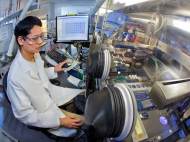WANDA robot – a new approach to nanocrystal manufacture
 Berkeley Lab scientists have made a nanocrystal-making robot, capable of producing nanocrystals with amazing precision. This robot, named WANDA (Workstation for Automated Nanomaterial Discovery and Analysis), provides colloidal nanocrystals with custom-made properties for electronics, biological labeling and luminescent devices. Since it is controlled by software protocols, it simplifies the process to novice users without extensive chemistry experience.
Berkeley Lab scientists have made a nanocrystal-making robot, capable of producing nanocrystals with amazing precision. This robot, named WANDA (Workstation for Automated Nanomaterial Discovery and Analysis), provides colloidal nanocrystals with custom-made properties for electronics, biological labeling and luminescent devices. Since it is controlled by software protocols, it simplifies the process to novice users without extensive chemistry experience.
“WANDA makes nanocrystals of exceptional quality – every time – optimized for different applications,” said Delia Milliron, Director of the Inorganic Nanostructures Facility at the Molecular Foundry. “We’re providing these to users and now just starting to use WANDA to discover new nanocrystal compositions with advantageous properties.”
WANDA’s liquid-handling robotics prepare and initiate reactions by injecting nanocrystal precursor chemicals into an array of reactors. After a series of reactions is complete, the structural and optical properties of these nanocrystals can be screened rapidly, also using automated methods. WANDA is housed inside a nitrogen-filled chamber, designed to keep oxygen and water from interacting with reactive precursor chemicals and freshly formed nanocrystals.
Milliron and her coauthors at the Foundry and University of California, Berkeley, have directed WANDA to produce and optimize a diverse set of nanomaterials under conditions analogous to those employed in traditional flask-based chemistry. Starting with widely studied and practically useful nanomaterials (such as cadmium selenide quantum dots, whose size can be adjusted to emit different colors of visible light) the team showed how WANDA can optimize the size, crystal structure and luminescence properties of different nanocrystals.
“This technology will change the way nanoscience research is performed,” said Emory Chan, a senior scientific engineering associate at the Molecular Foundry. “Not only does WANDA enable the optimization and mass production of nanoparticles our users need, but this robot also facilitates experiments that give us a deeper understanding into the chemistry and physics of nanoscale materials.”
You can find more information in a paper reporting this research titled “Reproducible, high-throughput synthesis of colloidal nanocrystals for optimization in multidimensional parameter space”.









Leave your response!